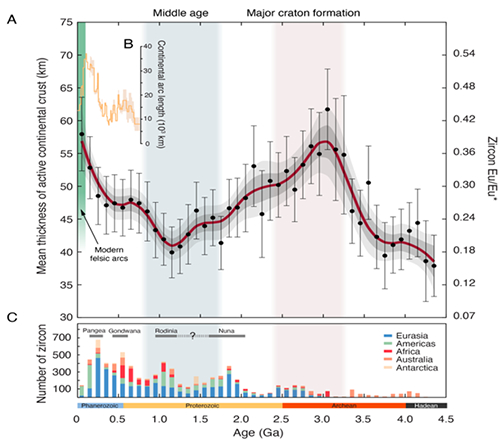Chinese scientists discovered orogenic quiescence in Earth's middle age
With the support of the National Natural Science Foundation of China (Grant No. 41888101, 91755000 and 42073026), a team of Earth science researchers from Peking University, University of Toronto and University of Science and Technology of China recently used detrital zircons to reconstruct mountain building processes over Earth's history. They discovered a one-billion-year period of reduced orogenic activity in Earth's middle age (1.8-0.8 billion years ago) and raised the hypothesis of orogenic quiescence in Earth’s middle age . Their findings have important implications for nutrient cycling, supercontinent cycles, plate tectonics and life evolution. This work was published online in Science on February 12th, 2021 (https://science.sciencemag.org/content/371/6530/728).

Figure 1. Reconstructed active continental crust thickness from Eu anomalies in detrital zircons.
Erosion and weathering of the continental crust provides life-essential nutrients to the oceanic biota. The global flux of erosion and weathering is dominated by mountain belts. Because of gravitational instability and high erosion efficiency, mountain belts generally worn away quickly, making it challenging to track mountain building processes in the past. Dr. Ming TANG and his coauthors applied their recently calibrated Eu-in-zircon proxy to global detrital zircons and reconstructed the orogenic history since the Hadean. Their findings reveal significant changes in orogenic activity over billion-year timescales. In particular, the Proterozoic witnessed gradually reduced orogenesis. Dr. Tang and his collaborators coined the terminology "orogenic quiescence" for this phenomenon.
This work further shows that the middle-age orogenic quiescence may have led to reduced erosion and weathering on the continents and thus muted the nutrient supply to the oceans. As a consequence, the primary production in the oceans may have collapsed, and this widespread famine may have hindered life's evolution through much of the Proterozoic.
Dr. Tang and his team linked this middle-age orogenic quiescence to the unusual supercontinent cycle in the Proterozoic. They suggested that the Nuna and Rodinia supercontinent cycles may have been a single coherent supercontinent cycle based on a number of recent observations. The Nuna supercontinent transitioned into the Rodinia supercontinent through only minor reconfigurations. This long-lived supercontinent may have significantly altered the thermal structure of the mantle, changed the style of plate tectonics and weakened the continental lithosphere, which ultimately reduced orogenic activity in Earth's middle age.
Contact Us

National Natural Science Foundation of China
Add: 83 Shuangqing Rd., Haidian District, Beijing, China
Postcode: 100085
Tel: 86-10-62327001
Fax: 86-10-62327004
E-mail: bic@nsfc.gov.cn
